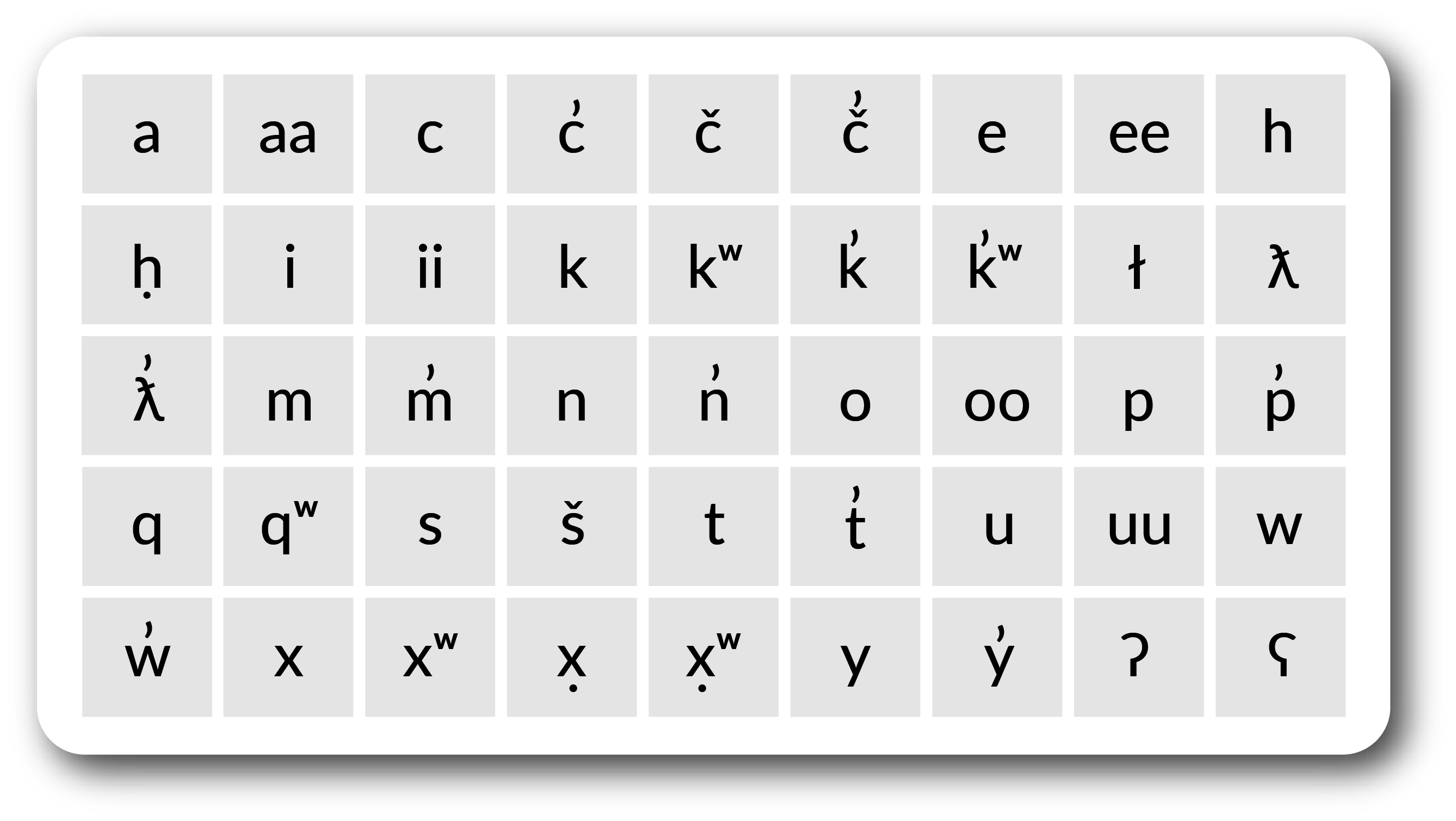Nuu-Chah-Nulth Alphabet


Introduction to the NCN alphabet
This tutorial explains how to read and pronounce each letter of the Nuu-Chah-Nulth alphabet, using examples from the Northern dialect.
The Nuu-Chah-Nulth alphabet has forty-five letters. The letters, in alphabetical order, can be seen in the table above.

The alphabet above is inclusive and intended to be usable for all Nuu-Chah-Nulth dialects. Although some letters are rarely used in some dialects, every letter is used in at least one dialect. In particular, the letters e, ee, o, oo, x̣, and x̣ʷ tend to be rare. Rare letters are pointed out as they come up in the tutorial.
The rest of the tutorial discusses the letters of the alphabet according to what kinds of sounds they are. We begin with the vowels, and then move to the various kinds of consonants. The consonants are discussed roughly from those that are easiest for English speakers to pronounce to those that are most difficult.
The Nuu-Chah-Nulth alphabet has ten vowels: a, aa, e, ee, i, ii, o, oo, u, and uu. Vowels are singable sounds made with open mouth and throat. Nuu-Chah-Nulth vowels can be long or short. Long vowels are pronounced about twice as long as short vowels, and are written with double letters.
This table gives some information on each vowel, including its name and how it is pronounced.
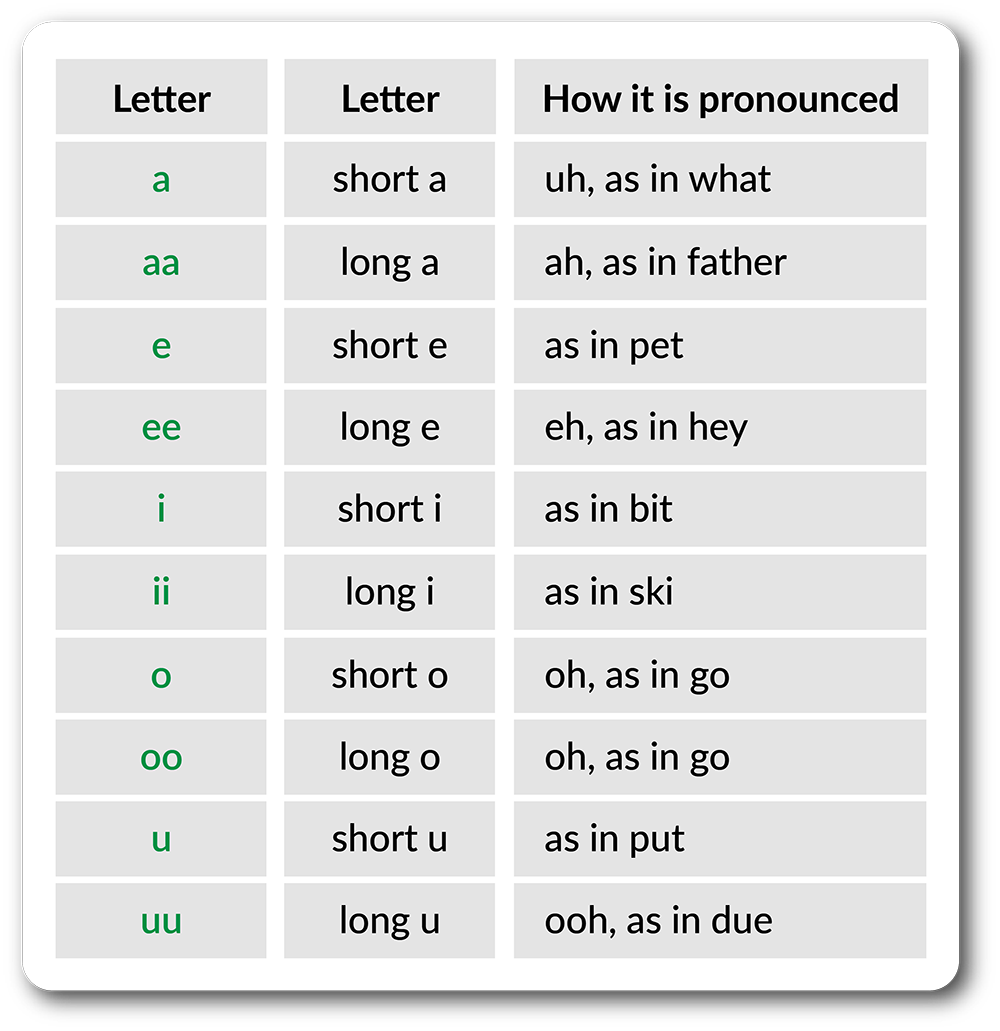
Here are some examples:
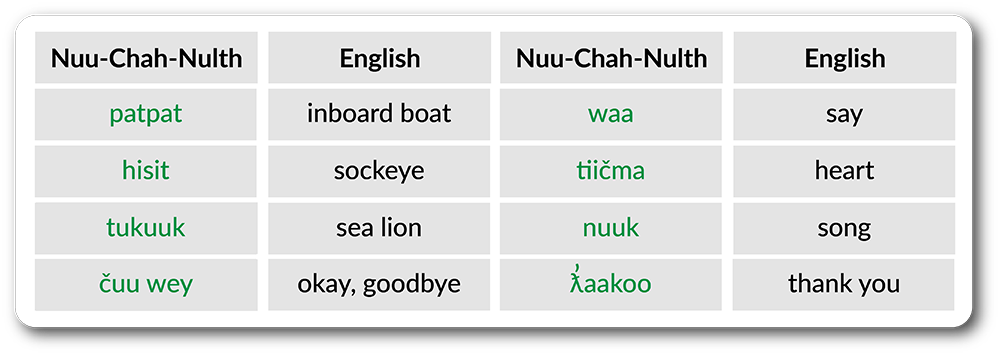
The pronunciations given here are only these vowels’ usual pronunciations. Vowels can be pronounced slightly differently at the ends of words, and next to certain consonants. In particular, the back consonants q, qʷ, x̣, x̣ʷ, ḥ, and ʕ tend to affect the pronunciation of nearby vowels.
In northern and central Nuu-Chah-Nulth dialects, the vowels e and ee are rare. The short o is rare in all dialects.
The Nuu-Chah-Nulth alphabet has thirty-five consonant letters. Consonant sounds are quieter and less singable than vowels.
The following table illustrates that consonants can be compared based on where they are made (lips, tongue tip, tongue back, or throat), and on how they are made (plosives, fricatives, or resonants).
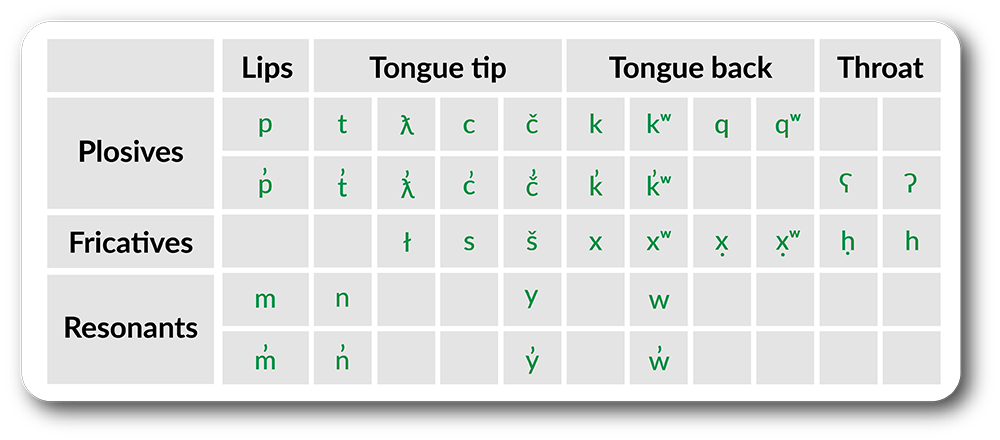
This diagram shows where in the mouth and throat Nuu-Chah-Nulth consonants are made, using p, t, č, k, q, ʕ, and ʔ as examples.
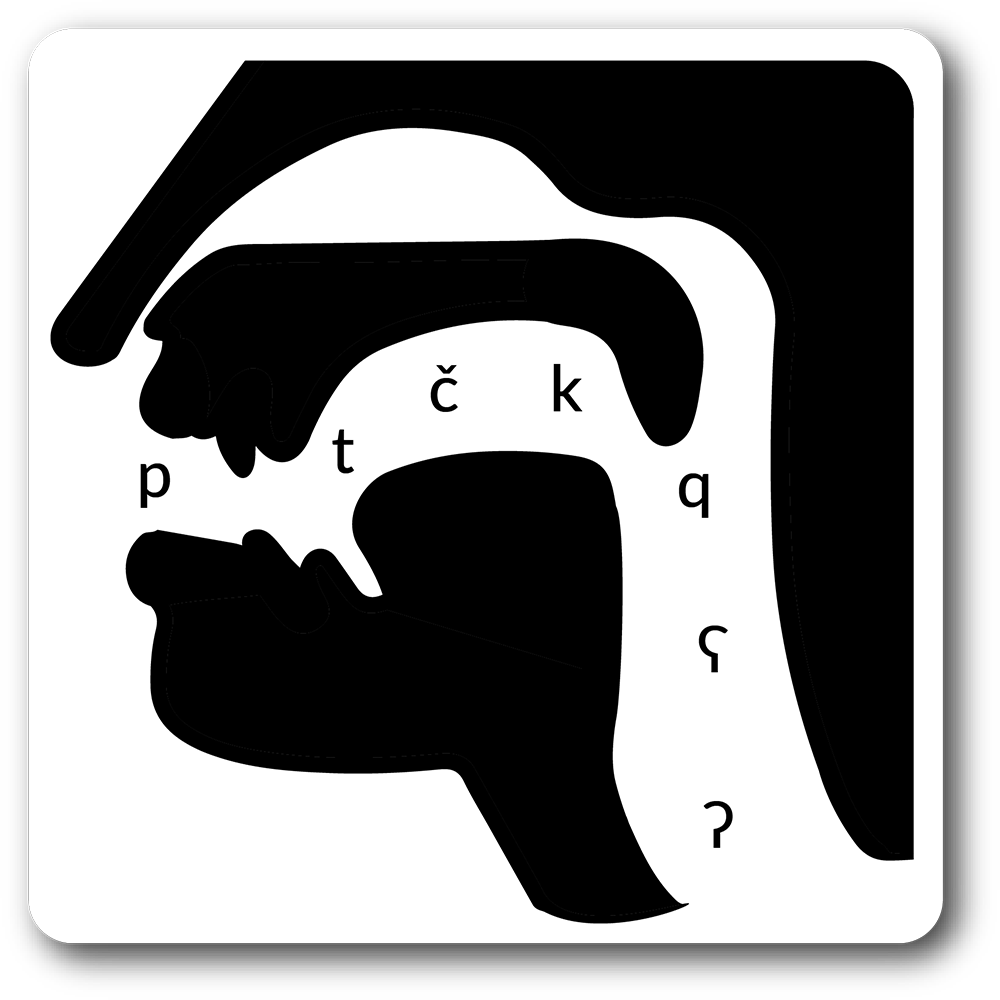
The rest of the tutorial describes each consonant in turn, roughly from easiest to hardest. We will not say very much here about the differences among plosives, fricatives, and resonants. However, it is important to understand the difference between hard plosives and hard resonants, and these are discussed at the end of the tutorial.
The consonant letters h, k, m, n, p, s, t, w, and y are common to both Nuu-Chah-Nulth and English, and are pronounced the same in both languages. Once you know how to pronounce the Nuu-Chah-Nulth vowels, you can read all of these words.
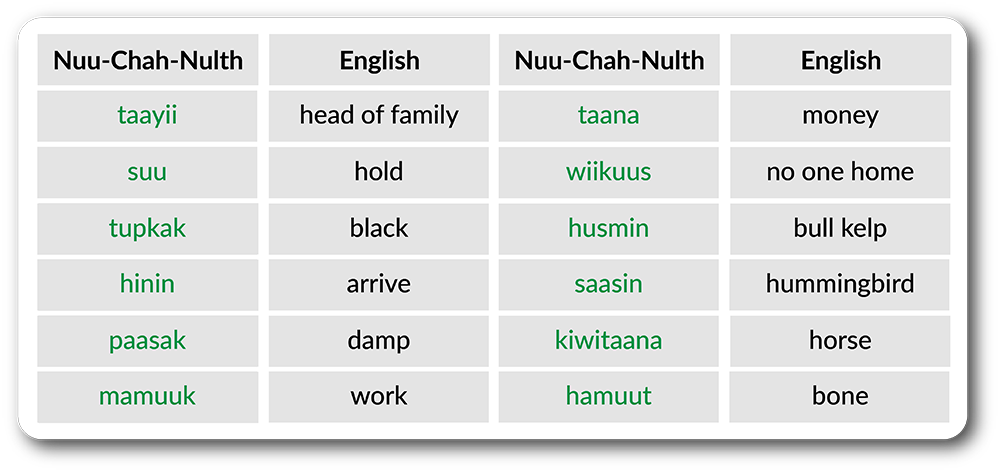
Many Nuu-Chah-Nulth consonants are made with the tip or blade of the tongue, including c, c̓, č, č̓, ł, ƛ, ƛ̓, n, n̓, s, š, t, t̓, y, and y̓. Most of these are discussed in other sections of this tutorial.
Here, we will focus on the letters c, č, and š, which represent sounds that are familiar in English, but are written differently in Nuu-Chah-Nulth.
These are their names, and how they are pronounced:
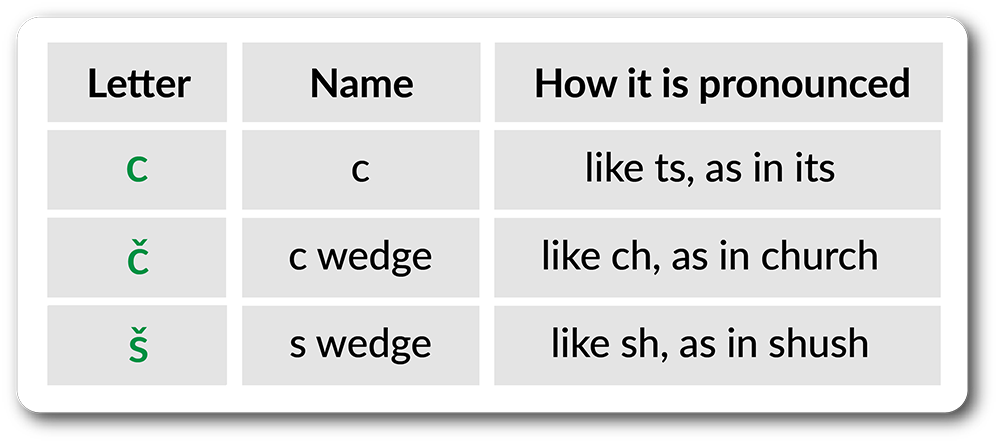
Here are some examples:
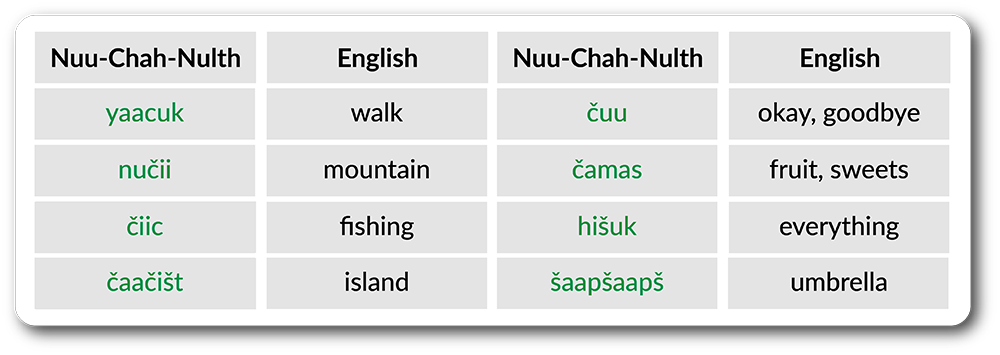
By contrast, the letters q and x look familiar, but represent different sounds in Nuu-Chah-Nulth and English. See the following sections.
Some other tip-of-the-tongue consonants are the three l sounds of Nuu-Chah-Nulth: ł, ƛ, and ƛ̓. None of these is the same as the English l sound, but they all have some l quality.
Here are some brief descriptions of these sounds:

To make the barred l (ł) sound, put your tongue in the same position you would to make an English l. But instead of humming, as you would for l, hiss past your tongue. This is why we sometimes call this consonant a “hissed l.” We sometimes hear a sound like this in English when an l is pronounced next to a hissing sound, as in the words wealth and athlete.
To make the barred lambda (ƛ) sound, pronounce a t sound, closely followed by an l, as in Atlantic. This sound is often written in English as cl or kl, but it is closer to tl. The hard barred lambda is discussed later in the tutorial, along with the other hard plosives.
Here are some examples:

Several Nuu-Chah-Nulth consonants are made with the back of the tongue:

Some of these are pronounced a little further forward on the tongue (k, kʷ, x, xʷ), while others are pronounced further back (q, qʷ, x̣, x̣ʷ). Both k and q sound to the English ear like k, but q is slightly rougher and lower in pitch, because of its backness. The front (plain) x sounds something like a cat’s hiss, while the back x̣ sounds something like the hawking sound one makes when clearing one’s throat. In addition, all of these consonants can be rounded—that is, pronounced with the lips in a w shape.
Here is another way of looking at the back-of-the-tongue sounds. First, they can be either plosives or fricatives. Plosives involve stopping and then releasing the breath in a small explosion, while fricatives are hissing sounds. Second, these sounds can be pronounced more front, or more back. Third, they can be pronounced with or without rounded lips. The combination of these three possibilities results in eight different consonants.
Here are some examples:

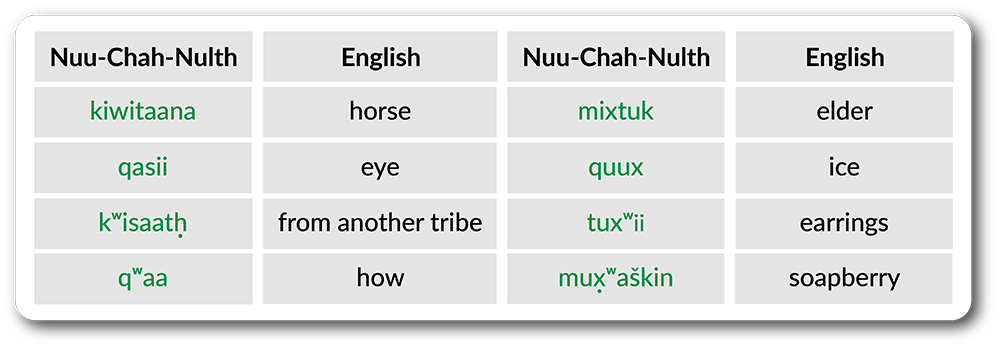
The back x̣ and x̣ʷ are rare in Nuu-Chah-Nulth, but are found in a few words.
The guttural or throat consonants are made low in the throat.

The plain h and glottal stop (ʔ) are both glottal sounds. This means that they are made at the vocal cords, which are at the very bottom of the throat. By contrast, the back ḥ and pharyngeal stop (ʕ) are pharyngeal sounds. They are made with the tongue root against the back of the throat, a little bit above the vocal cords.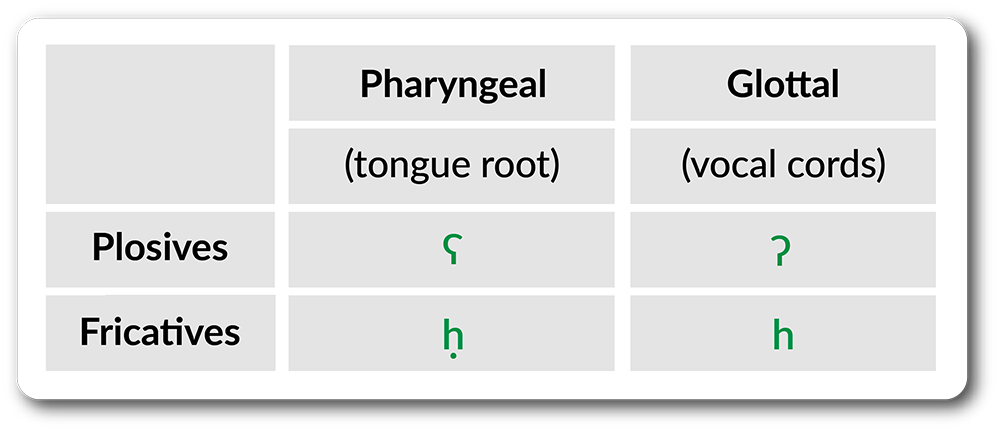 The glottal stop (ʔ) is just a catch in the throat. It is made by using the vocal cords to briefly stop the flow of air from the lungs. In English, the glottal stop is often pronounced just before vowels, but is never written. For example, there are two glottal stops in the English word uh-oh.
The glottal stop (ʔ) is just a catch in the throat. It is made by using the vocal cords to briefly stop the flow of air from the lungs. In English, the glottal stop is often pronounced just before vowels, but is never written. For example, there are two glottal stops in the English word uh-oh.
In Nuu-Chah-Nulth, the glottal stop is written, and can change the meaning of a word. To pronounce the pharyngeal stop (ʕ), make a glottal stop plus a weak r sound. With some speakers, this consonant can sound almost identical to the glottal stop (ʔ), while with other speakers, ʕ and ʔ are clearly different. To pronounce the back ḥ, tense your throat and exhale roughly, as if you were breathing on glass to clean it.
Here are some examples: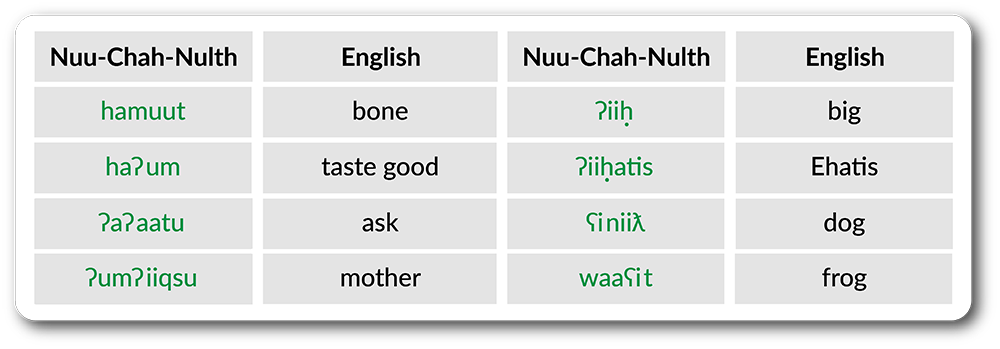 While the glottal sounds (h, ʔ) are not difficult for English speakers, the pharyngeal sounds (ḥ, ʕ) tend to be more difficult.
While the glottal sounds (h, ʔ) are not difficult for English speakers, the pharyngeal sounds (ḥ, ʕ) tend to be more difficult.
Hard or glottalized consonants are made like other consonants, but with an extra gesture at the vocal cords. Glottalization is pronounced differently on plosive versus resonant sounds. On plosive sounds, glottalization is pronounced as a stronger explosion. On resonant sounds, glottalization is pronounced as a catch in the throat. We will discuss hard plosives and hard resonants in turn.
All plosive consonants involve releasing the breath in a small explosion of air. The hard plosives c̓, č̓, k̓, k̓ʷ, ƛ̓, p̓, and t̓ are like their plain counterparts, but are pronounced with a stronger explosion.
Here are some examples: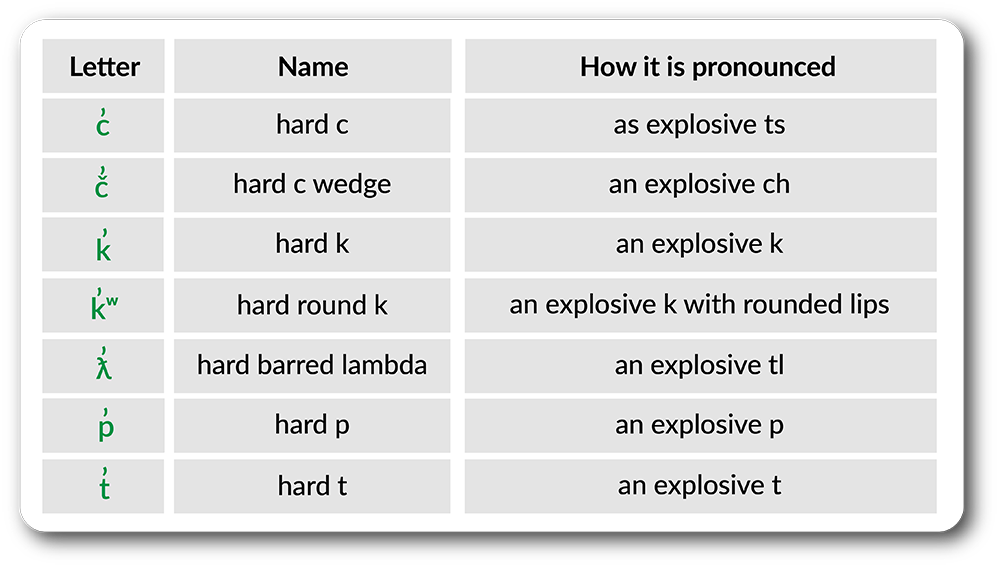 Here is a trick to help you learn how to pronounce the hard plosives. Try saying them while holding your breath at your vocal cords, so that no air can go in or out of your lungs. Even while holding your breath, you can still pronounce hard plosives, because the air for them comes from the mouth and throat, rather than from the lungs. By contrast, plain plosives require air flowing out from the lungs, and cannot be said while holding your breath.
Here is a trick to help you learn how to pronounce the hard plosives. Try saying them while holding your breath at your vocal cords, so that no air can go in or out of your lungs. Even while holding your breath, you can still pronounce hard plosives, because the air for them comes from the mouth and throat, rather than from the lungs. By contrast, plain plosives require air flowing out from the lungs, and cannot be said while holding your breath.
Here are some examples: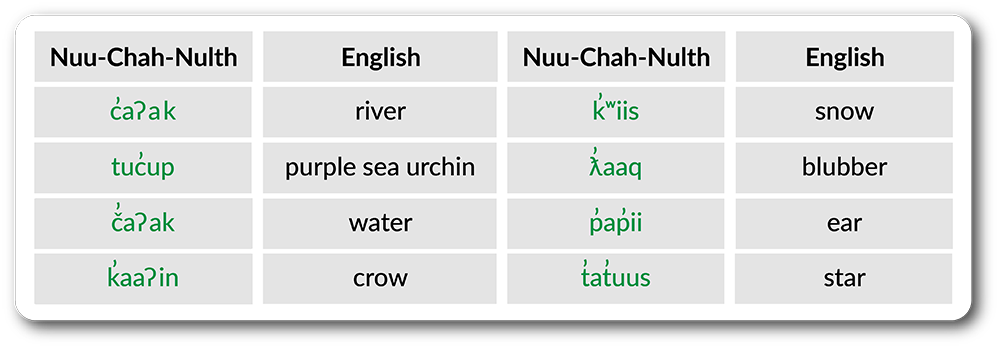
The last consonants that we will discuss are the hard resonants.
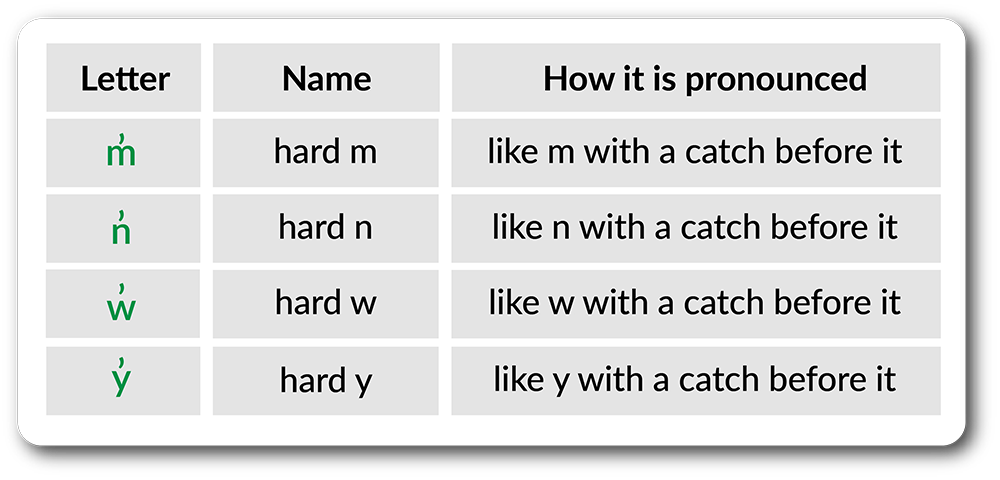 Resonant consonants like m, n, w, and y are humming sounds, made with vibrating vocal cords. The glottalized or hard resonants m̓, n̓, w̓, and y̓ are pronounced like their plain counterparts, but are a little longer, and are preceded by a catch in the throat like a glottal stop (ʔ).
Resonant consonants like m, n, w, and y are humming sounds, made with vibrating vocal cords. The glottalized or hard resonants m̓, n̓, w̓, and y̓ are pronounced like their plain counterparts, but are a little longer, and are preceded by a catch in the throat like a glottal stop (ʔ).
Here are some examples:
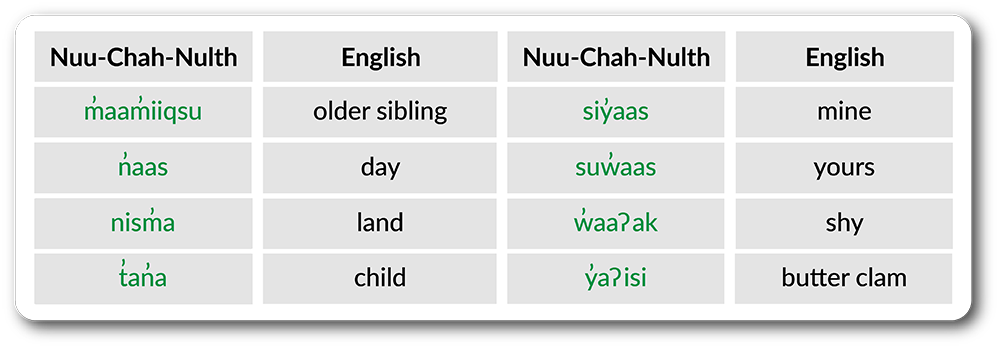 Glottalization on resonants is not difficult to hear between vowels, as in suw̓aas, but it can be very difficult to hear at the beginnings of words, as in w̓aaʔak.
Glottalization on resonants is not difficult to hear between vowels, as in suw̓aas, but it can be very difficult to hear at the beginnings of words, as in w̓aaʔak.

Now listen to the sounds of the alphabet.

This is a video of the late Linda Watts teaching the alphabet on YouTube.
There are several very good videos with Linda on YouTube that will be very useful in learning to speak the language.

